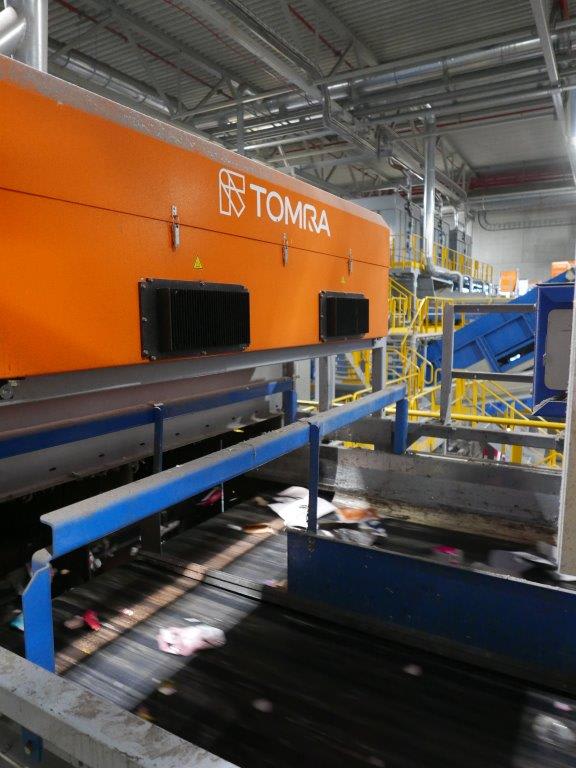Leading the way with Tomra technology
When Tomra was selected as technology provider of IVAR’s waste sorting plant, it was clear that the most advanced sensor-based sorting technology was required. Specifically, Tomra provided 22 of its state-of-the-art AUTOSORT® machines to extract both paper and plastics from household waste. Outstanding technologies and leading-edge features make AUTOSORT® unique.
Equipped with sophisticated infrared sorting technology, which combines near infrared (NIR) and visual spectrometer (VIS), the machine can accurately and quickly identify and separate different materials according to their material type and color. In Forus, AUTOSORT® machines sort paper into three and plastics into six target fractions. Its sorting accuracy is mainly based on the integrated, patented FLYING BEAM® technology, which evenly distributes light across the entire conveyer belt and scans and analyzes all material passing through the scanner. The sensor sends the respective signal to the machine’s valve blocks which turn the scanner’s information into action, either ejecting or dropping scanned items.
Rudolf Meissner, Chief Supervisor, Waste Sorting Systems at IVAR, stated: “Tomra’s sorters and consultancy convinced us right from the beginning. As we have experienced firsthand, they are an essential tool for automated waste sorting, running high throughput and generating high yield and purity levels alike – the goal all sorting plants are pursuing and the reason why these machines definitely belong in any modern sorting and recycling facility. Combined with their reliable service, we could turn our waste sorting process into a cost effective and competitive activity.”
When starting operations in 2019, IVAR set an overall goal to recover nearly all plastic types (PE, PP, PS, PET) and a more concrete target to realize purity rates of 95-96% in LDPE, PP, HDPE, PS and PET sorting. Thanks to the ultraprecise sorting machines, the plant’s goal soon became reality, with purity rates of up to 98% achieved. As for paper, sorting studies have shown that more than 85% of all beverage cartons in the residual household waste have been successfully separated from the household waste stream.

A new life for plastics
After extraction of recyclables from the infeed material, the sorted fractions undergo an extensive recycling process on-site. Whereas homogenous PET and PS bales as well as both ferrous and non-ferrous metals are sold to European recyclers, Polyolefins (LDPE, HDPE, and PP) are shredded into flakes, hot washed, dried and pelletized on-site before these are sold as industrial commodities. Thousands of tons of PE and PP recovered from MSW have been diverted from incineration and to be integrated in the production of high-quality PO recyclates.
Cutting down environmental impact
The business case at IVAR proves that sorting prior to disposal can preserve recyclable materials previously incinerated and strongly contribute to climate protection. Prior to opening the waste sorting plant, the separate collection rate in the region served by IVAR was high: 65% of the waste collected in the municipalities was sorted. However, with the plant fully operational, the recovery rates of recyclables are now as high as 74%.
From an environmental perspective, sorting, recovering, and recycling plastics from mixed waste streams – instead of relying solely on material-dedicated collection systems – leads to a two-fold reduction in CO2 emissions. First, less plastics, that comes with a high caloric value but based on fossil carbon, are incinerated. Second, the provision of high-quality recycled plastics reduces the need for primary production. Thus, IVAR contributes to delivering environment-friendly feed and works in line with the principles of a circular economy, resulting in a decrease of 33,000 metric tons of CO2 emissions a year, which is equivalent to taking 20,000 fossil fuel cars off the road.
Looking back and beyond
The results have clearly shown that MSW sorting before incineration brings numerous benefits: in Norway, the need for separate collection of plastics packaging, and its associated costs, has been eliminated and enabled IVAR to provide ready-for-market recycled material for new products and packaging, while reducing its CO2 footprint considerably. Furthermore, the partners have already started to investigate if glass and biowaste could be profitably extracted from the fines fraction (0-60 mm).
Automating the sorting process with the latest technology has strongly contributed to this change. However, the partners are convinced that automation only complements waste sorting but will never replace local separate waste collection systems. Rather, the components of optimal waste management must go hand in hand - from collection to mixed waste sorting to recycling – to have the biggest impact on how much we recycle. In Norway, we see that it works.


